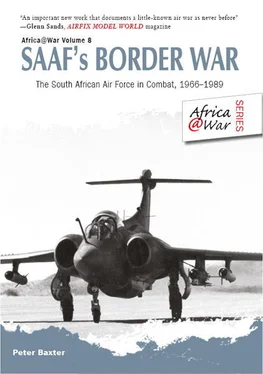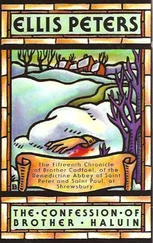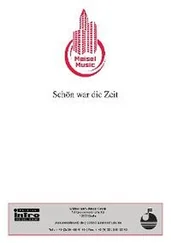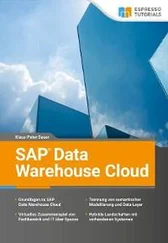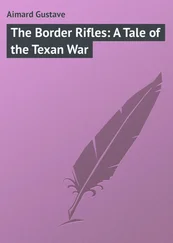Peter Baxter - SAAF's Border War
Здесь есть возможность читать онлайн «Peter Baxter - SAAF's Border War» весь текст электронной книги совершенно бесплатно (целиком полную версию без сокращений). В некоторых случаях можно слушать аудио, скачать через торрент в формате fb2 и присутствует краткое содержание. Город: Solihull, Год выпуска: 2013, ISBN: 2013, Издательство: Helion & Company, Жанр: military_history, на английском языке. Описание произведения, (предисловие) а так же отзывы посетителей доступны на портале библиотеки ЛибКат.
- Название:SAAF's Border War
- Автор:
- Издательство:Helion & Company
- Жанр:
- Год:2013
- Город:Solihull
- ISBN:978-1-908916-23-5
- Рейтинг книги:3 / 5. Голосов: 1
-
Избранное:Добавить в избранное
- Отзывы:
-
Ваша оценка:
- 60
- 1
- 2
- 3
- 4
- 5
SAAF's Border War: краткое содержание, описание и аннотация
Предлагаем к чтению аннотацию, описание, краткое содержание или предисловие (зависит от того, что написал сам автор книги «SAAF's Border War»). Если вы не нашли необходимую информацию о книге — напишите в комментариях, мы постараемся отыскать её.
SAAF's Border War — читать онлайн бесплатно полную книгу (весь текст) целиком
Ниже представлен текст книги, разбитый по страницам. Система сохранения места последней прочитанной страницы, позволяет с удобством читать онлайн бесплатно книгу «SAAF's Border War», без необходимости каждый раз заново искать на чём Вы остановились. Поставьте закладку, и сможете в любой момент перейти на страницу, на которой закончили чтение.
Интервал:
Закладка:

The active zones of insecurity throughout the late 1960s and early 1970s were focused on Rhodesia, Mozambique and Angola, the former being under the control of a white rebel government and the latter pair being governed in the Portuguese style as overseas provinces. In the case of Mozambique the local dynamics were reasonably straightforward. FRELIMO was an authentic, Marxist-orientated unity movement representing all the indigenous peoples of the territory and bonded by the charismatic and strong leadership of Samora Machel. In Angola, however, matters were a great deal more opaque. The liberation struggle here took form from a number of regional and ethnic threads that coalesced eventually into three separate and constituted but mutually antagonistic liberation movements. It therefore stood to reason that the war of liberation was really nothing more than the first phase of a civil war that would not be decided until the Portuguese had left the scene, after which matters could be concluded between the three opposing nationalist movements.
The senior and arguably the most politically radical of these movements was the MPLA, the People’s Movement for the Liberation of Angola, centred around and ethnically supported within the capital of Luanda. Representing the north of Angola and overlapping into recently independent Zaire, was the rightleaning FNLA, or the National Liberation Front of Angola. A breakaway faction of this organization was the National Union for the Total Independence of Angola, or UNITA, centred in the southeast of the country, pro-west and ideologically irreconcilable with either the MPLA or the FNLA.
So long as the Portuguese held substantive political control of Angola, all that fundamentally concerned South Africa with regard to the security of her long-shared proxy border with Angola was the threat posed by SWAPO which, although extremely scrappy and highly militant in terms of its language and posturing, could do little more than irritate South African border security from its rear bases in Zambia. A glance at a map of the region will illustrate this fact clearly. The 1,000 kilometres or more of arid frontier that separates present-day Namibia from its northern neighbours is only touched by Zambia at the far end of the Caprivi Strip. This invited SWAPO combatants to either challenge the South Africans at their point of strength around the four corners of Zambia, Rhodesia and Botswana or to infiltrate Angola overland the entire length of the frontier to Owamboland on the northwestern edge of the country in order to merge with the ethnically sympathetic Owambo who provided the bedrock of support for SWAPO. And while this was possible, it hardly offered a platform for a serious military challenge and indeed no such challenge was ever really offered.
SWAPO, in keeping with the liberation ideology of Mao, from which many in the region drew their tactical inspiration, forswore trading punches with a dominant army entrenched in its territorial heartland but instead focused on the wider politicization of masses in a battle for hearts and minds, a battle that white South African youth, conscripted for the most part from the industrial and urban centres of South Africa, had lost before they had even reached the border.
In fact, during the early phases of the Border War, the fighting was not army business at all, but a police affair. This was also the case in similar situations elsewhere. There was always a marked reluctance on the part of any colonial authority to acknowledge that local insecurity was anything more than a civil disturbance. If an internal insurgency could be dealt with primarily by the civil power then it need not be defined as a war, which in turn criminalized violent political activity in the countryside which tended to rob it of the legitimacy of protest.
Such was the case in South West Africa, with responsibility for confronting the insurgency falling not to the SADF, which retained a presence in the region and acted only when requested to do so in support of the South West African Police (SWAPOL).
For the most part the police incident reports that were filed tended to paint a picture of the usual hit-and-run-type insecurity involving isolated and vulnerable targets such as the widely dispersed white farmsteads or white-owned rural stores, with frequent killings of local chiefs and other blacks perceived to be loyal to the government. Very seldom was an attack recorded against a defended government facility and even less frequently against any part of the defence establishment itself. Police and army casualties were most frequently caused by landmines which were easily laid and difficult to detect and were the preferred offensive weapon of insurgent units. Large numbers of police personnel, and perhaps even more civilians, were killed or maimed by the widespread use of landmines.
The South African Police response tended to involve wide-ranging reconnaissance patrols that rarely succeeded in running mobile insurgent units to ground but kept them on the move, preventing the establishment of any permanent or semi-permanent facilities within South West Africa. Portuguese military activity in Angola had limited effect even on its own internal enemies, let alone SWAPO, but friendly entente between the two territories did at least prevent SWAPO from gaining any permanent foothold in that country.
Air support for police patrols and counter-insurgency operations was provided by two seconded SAAF Alouette IIIs, one of which was lost in April 1966 during a night flight when the pilot strayed over the ocean.
The point at which this level of insecurity escalated to something more akin to war was in August 1966 when a combined SWAPOL/SADF/SAAF operation codenamed Operation Blouwildebees took the fight to the enemy in Angola. Intelligence reports during February/March 1966 indicated the presence near the Luenge National Park in Angola of a large unit of SWAPO preparing to move into the politically alert Owamboland region of South West Africa, having exfiltrated Zambia and made its way westward along the extended frontier. The matter was investigated and confirmed. An operation was then tabled to deal with the group, scheduled for 26 August 1966.
The plan involved a simple airborne assault on the known location of the group, utilizing an additional six Alouette IIIs flown by pilots trained specifically to operate without flight engineers. This was in order to allow for a complement of six fully-equipped police reaction force personnel or army paratroops which would not have been possible with the addition of a flight technician on board. Each helicopter was adapted to allow troops to exit on a knotted rope should the thick woodland of the target area prevent a landing. This required the pilot, while flying with his right hand, to retrieve the rope with his left. The operation involved three administrative branches of the defence establishment and was commanded respectively by Brigadier Jan Blaauw for the SAAF, General Pat Dillon for the police and Brigadier Renfree and Major Paetzold for the SADF.
The small armada of seven helicopters took to the air at zero hour and navigated carefully toward the target, following the directional advice of an informer. The drops occurred largely without mishap, after which a brief but ferocious firefight ensued against a dug-in and spirited, although largely outclassed enemy.
The enemy was armed primarily with the venerable but rather obsolete Soviet World War-era PPSh-41 sub-machine gun that fired a 7.62 pistol round which could hardly be effective against the hard-punching South African RIs (FAL variant) fielded by the assault force and neither, for that matter, the airborne mounted machine guns that in fact accounted for most of the enemy deaths that day. Bows and arrows also happen to have been found on the scene but these, it was later established, were not intended as offensive weapons but for hunting purposes in a situation where random gunfire would obviously have been inadvisable.
Читать дальшеИнтервал:
Закладка:
Похожие книги на «SAAF's Border War»
Представляем Вашему вниманию похожие книги на «SAAF's Border War» списком для выбора. Мы отобрали схожую по названию и смыслу литературу в надежде предоставить читателям больше вариантов отыскать новые, интересные, ещё непрочитанные произведения.
Обсуждение, отзывы о книге «SAAF's Border War» и просто собственные мнения читателей. Оставьте ваши комментарии, напишите, что Вы думаете о произведении, его смысле или главных героях. Укажите что конкретно понравилось, а что нет, и почему Вы так считаете.
